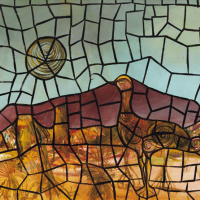66. SIDNEY NOLAN

Sidney Nolan was a great lover of birds and of all things avian. Birds and flight reappear time and again in his paintings and drawings. Several important bird paintings were produced in 1948, following an extended tour of Central, Far North and Western Australia. These are now universally regarded as figuring among Nolans most classic and endearing images.
In March 1948, Sidney Nolan married Cynthia Hansen, ne Reed, and they settled in the Sydney suburb of Wahroonga with her daughter Jinx. From June to September, Nolan and his new family set off on an outback trip. This was the first of many adventures to inland Australia and Nolan used the time to capture his experiences in photographs, notebooks and paintings, while Cynthia recorded her observations in a journal. Jane Clark has written eloquently on their extensive travels: They travelled by road, rail, air and sea: inland across New South Wales to Adelaide, north through the dead heart to Borroloola and Darwin, then down the coast to Western Australia via Halls Creek, Derby, Broome, Geraldton and Perth; and then back to Sydney.1
Ayers Rock (Uluru) was one of the destinations on their itinerary. Cynthia Nolan recorded that flying low over the Musgrave Ranges, out to Ayers Rock, Sidney gazed with his mouth open and his tongue pushed between his teeth, as he does when painting with the greatest intensity.2 Nolan was as excited by the native flora and fauna as he was by the ancient topography, mountain ridges and waterways. He was also intensely interested in the lives and customs of the first Australians, who had made these far away and seemingly desolate expanses their home for over 40,000 years.
Bird (1948) was one of a series of large paintings of imaginary birds that Nolan worked on in his Sydney studio during the latter part of that year. Most of these were exhibited the following year at David Jones Art Gallery where they received favourable reviews.3 This work combines Nolans observations in Central Australia with other more bizarre and invented motifs. The central mountainous formation is surely based on the distinctive shape of Uluru. The beautiful purple tinge and the blue-green sky recall the look and feel of Uluru and the surrounding ranges at night as the light fades and the desert grows cold. The low-lying tussock grasses and ochre sand are also based on direct observation and show Nolans affinity with the area.
Into this desert landscape Nolan places a strange out-of-scale bird. Earth-bound, with web feet, smallish wings and a long neck, it is most likely an amalgamation of several different types of birds that he encountered on the trip; the Darter or snakebird, cranes and even a hint of an emu. The over-sized bird appears at home in the primordial landscape. Nolan emphasises this by outlining the bird in black and using the colours and forms of the landscape as infill. The concentric circles in the body of the bird are also repeated in the large moon in the sky. Here, Nolan was almost certainly influenced by the rock art of Uluru which feature the same motif in several of its accessible ledges and caves.
The impact of Aboriginal art and culture on Nolan also helps to explain the web of dark black lines that he has laid over the entire scene. Although in many ways a man of his times, Nolan was also acutely aware of the importance of Aboriginal custodianship and how this relationship with country was reflected in songs, ceremonial body design and rock and sand art.
Bird is ahead of its time: unlike other works from the 1948 outback paintings that focus on a human presence in the Australian landscape from the time of European settlement, this work pays respect to the traditional owners and their land.
Footnotes
1. Clark, J., Sidney Nolan: Landscapes and Legends, National Gallery of Victoria, Melbourne, 1997, p.95
2. Nolan, C., Outback, Methuen, London, 1962, p.22
3. See The Sun, 8 March 1949
Rodney James BA (Hons), MA